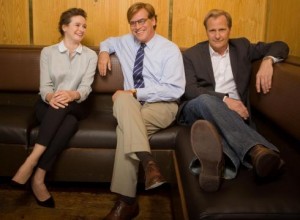Now that we’re a few episodes deep into the first season of Aaron Sorkin’s The Newsroom, its similarities with The West Wing are obvious. Unlike its older brother, however, The Newsroom has been derided as “patronizing,” “pretentious,” and, sadly, “naïve.” But why?
One would think that the strength of Sorkin’s formula would win out. Like The West Wing, The Newsroom is earnest and political. It has the same idealistic male lead (Jed Barlet, Will McAvoy) surrounded by his advisors: the old, wise one (Leo McGarry, Charlie Skinner); the clever, strong woman (C.J. Cregg, Mackenzie McHale); the quiet intellectual of modest origin (Charlie Young, Neal Sampat); and the semi-clueless, warm-hearted assistant (Donna Moss, Maggie Jordan).
Both shows are set in bustling offices, and filming rarely moves outside the confines of the titular locations. Both shows have the same, quippy Sorkin dialogue. Yet strangely, while both shows are supposed to appeal to moderate-liberals fond of wit and spontaneous, impassioned monologues, The Newsroom has been panned. The common complaint is that it is too preachy, with none of The West Wing’s charm.
Really, the only difference is that The Newsroom is stuck in the past—quite literally. The show’s present actually takes place in 2010, allowing the producers to avoid filming their own news clips while permitting Sorkin to assume omniscience. Each episode’s plot is constrained by the real-world events that already happened, and that, unfortunately, is the true weakness of the show.
The audience knows what happened to the oil spill, economy, and elections of two years ago. Because we know, the storytelling matters that much less, and the lectures become that much more pronounced. The Newsroom cannot have the equivalent of The West Wing’s Qumari assassination, Rosslyn shooting, or Santos election.
The characters aren’t quite so compelling either. One is never sure what drives anchorman Will McAvoy, mostly because he seems unsure too. He claims to love facts and identifies as a moderate Republican, but Sorkin never takes the time to explain why. Unlike The West Wing’s smart, articulate Ainsley Hayes, McAvoy seems to be Republican because Sorkin thought it might appeal to more demographics. Without any knowledge of McAvoy’s convictions, there is no reason why an audience would want to understand his sermons.
Sorkin tries to impact society with his work, yet his show about how news media could change the world is far less impactful than his description of fictional presidential advisors. Instead of suggesting that his audience reexamine the types of stories they see now, Sorkin criticizes them for failing to understand the ones of two years ago—another flaw of the structure. The West Wing, as the HPR’s Matt Shuham notes, spurred students to enter public service. For some reason, it seems unlikely that The Newsroom will have the same effect.
The Newsroom is an entertaining show—and one compelling enough to keep me watching through the summer—but it cannot have the same impact that The West Wing did. The structural issues of the show, especially the time setting and the ill-developed characters, have so obscured the message Sorkin is trying to present that he resorts to repeating it over and over until the audience has been lectured into submission. His mistake with The Newsroom is simply that, in trying to replicate his earlier success, Sorkin looks too far back.
Photo Credit: Todd Plitt, USA Today
